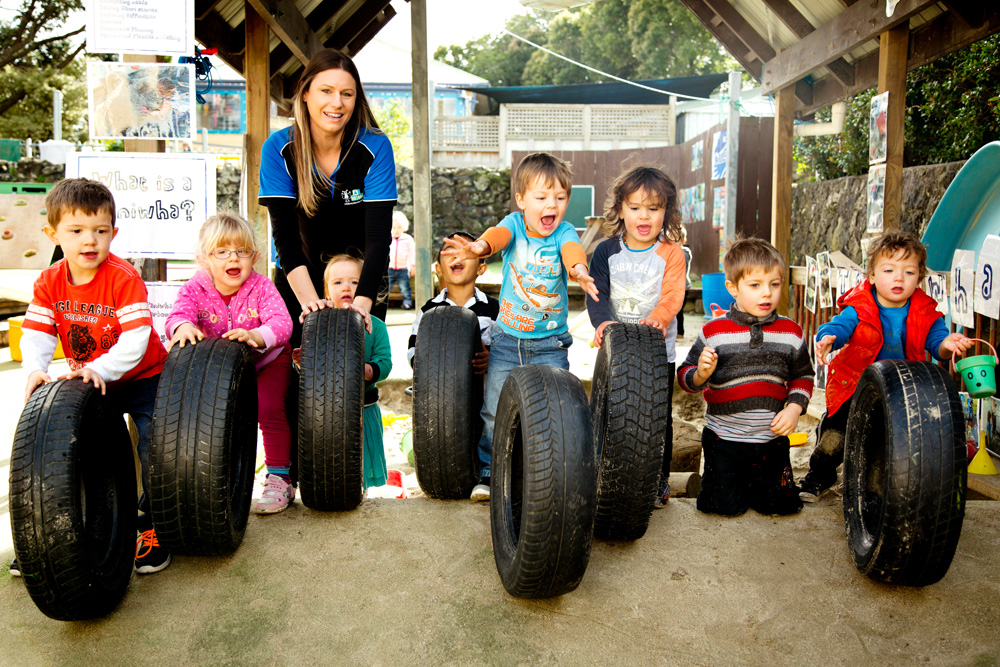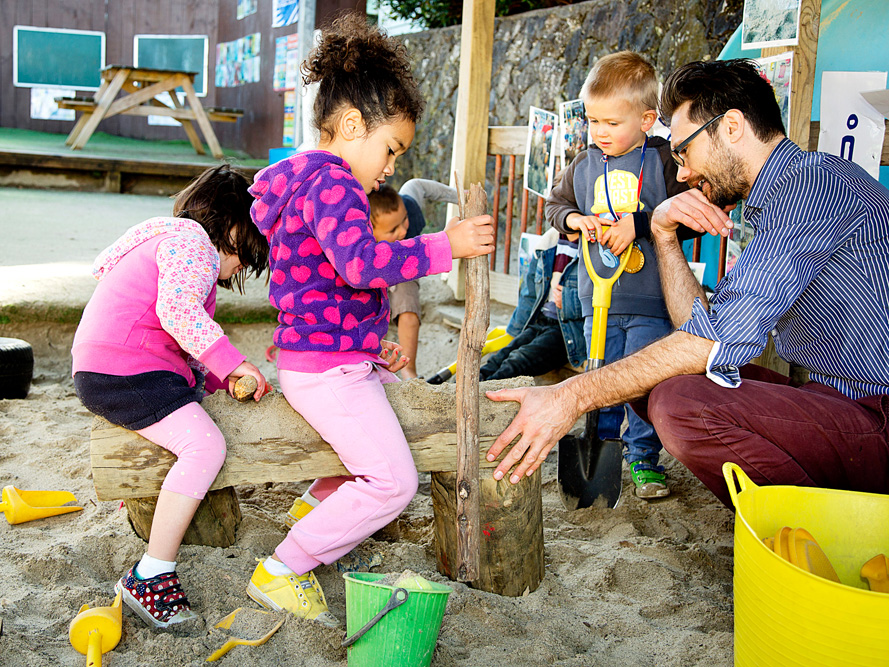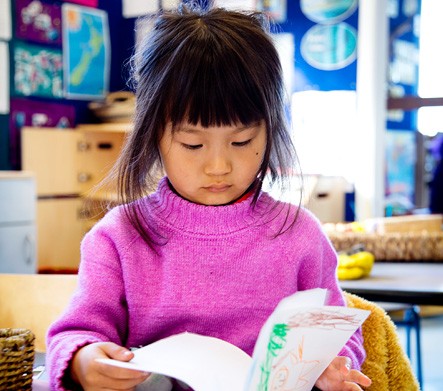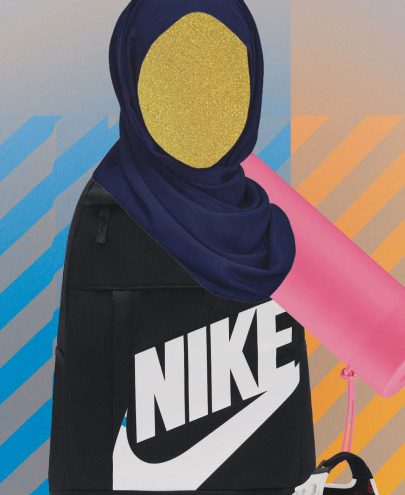Oct 24, 2014 Schools
What happens in daycare centres when parents aren’t around? We sent an early childhood teacher in to find out.
Photos by Jessie Casson.
It was music, of a sort, but The Wiggles it definitely was not.
At 1pm on a mid-winter Wednesday, the throbbing bass of a dub techno track — the sort of sound you might hear from the bowels of a bogan’s drag racer when it pulls up alongside you at the lights — was thumping in suburban West Auckland.
It was loud, it was unpleasant — and it was coming from the playground of a childcare centre.
It’s impossible to know what the parents of the 50 children who attend Aunty Maria’s, in Glendene, might think about the choice of music that afternoon. Like thousands of other Aucklanders, they drop their children off before work — sometimes around 7am — pick them up on the way home at 6 and have only a sketchy idea of what goes on in between.
For every parent having a long day at work, there is often a preschooler having an even longer one in a childcare centre. With more than 98 per cent of children attending some form of preschool, from home-based services to kindies, early education centres and playcentres, our enrolment rates are in the top third in the OECD.
Quality early childhood education is important, we are told, because it makes a lifetime of difference. One international analysis showed children who attend high-quality, half-day preschool programmes at ages three and four are, by the age of 40, more economically successful and more likely to own their own homes than non-participants.
Early Childhood Council CEO Peter Reynolds told this year’s annual conference that the government’s emphasis on the 20 free hours a week funding was a “bums on seats” rather than quality-based policy that would have serious consequences. Centres were actually getting less money per child hour despite the increase in money spent.
“When children turn up for school not knowing their letters, their numbers or their shapes, unable to hold a pen or sit still on the mat, having never experienced a stable, loving environment… When children turn up at school unable to problem-solve at even a basic level; unaware of social conventions of playing and interacting with other children and demonstrating no real resilience of their own…. When children arrive at school in this kind of shape, they learn from day one that they are not the sort to do well. They stop listening. They stop trying. They become disruptive. And then they become adults.”
He says studies conclude not that all early childhood education works, but that quality works.
So are our kids getting quality education, or just an expensive babysitting service? The only independent take comes from the reports, usually issued every three years, by the Education Review Office, which gives six weeks’ notice of an impending visit. Plenty of time for a centre to prepare, and for staff to be primed, attentive and doing things by the book on the day.

To get a more spontaneous snapshot of life in daycare, Metro sent early childhood teacher Khalla Herrick “undercover” into six Auckland early childhood centres, chosen at random, and asked her to report back on her observations. Herrick, 31, the mother of a preschooler and a six-year-old, has a diploma in early childhood education and 10 years’ experience in the job, including a period as a head teacher on the North Shore.
Now working as a relieving teacher while she studies psychology, Herrick posed as a parent looking to place her younger son and visited each centre twice, usually for several hours, at different times of the day — something the ERO advises other parents to do when they’re selecting childcare.
Of the six centres, Herrick fully endorsed only one — ABC in Walters Rd, Mt Eden. The report cards of the others she marked “could do better”. She suspects her key complaints will be common in hundreds of other centres nationally.
“It was a real eye-opener,” she says.
Her opinion isn’t shared by the ERO, however, who in the past year have found nearly 90 per cent of services operating well, or very well. In Auckland, only 17 of the 343 centres inspected have been operating so poorly they’ve been referred to the Ministry of Education to have their licence reviewed.
Despite the fact every centre Herrick visited had high percentages of fully qualified early childhood teachers when the government requires just 50 per cent, she found very little evidence the teachers were using their training to engage and stimulate the children. She says she encountered teachers who were so laidback they were “flat” and saw little passion or joy in the way they worked.
“In many cases, a babysitter could have done the same job.”
While the children seemed largely happy and occupied, in five of the six centres she noticed more interaction between the teachers than between the teachers and the children, with staff spending more time organising activities or tidying up.
Our results didn’t surprise ChildForum, a nationwide network that reviews childcare quality and regularly surveys its provider and teacher members. CEO Dr Sarah Farquhar says quality in early childhood education is “stagnating”.
She says one teacher had complained that staff at her centre were not allowed to pick up children to comfort them, saying many practices seemed to be about making the job easier for busy teachers — “hence no picking up or comforting children, as this takes time”.
A survey in May of 360 centre owners, managers, teachers and others involved with the sector found optimism slipping, with nearly two-thirds expecting things to get worse, predicting tightening
finances and greater competition, with too many new centres being licensed for the available children. Nearly 60 new centres have opened in Auckland alone in the past two years.
Here’s what Herrick found goes on:
AUNTY MARIA’S, GLENDENE
Licensed for 50 children, and usually has up to 50 enrolled in a converted house in Great North Rd. Its philosophy is that peer learning through social interaction helps children to develop independence, confidence, negotiation skills and tolerance. Uses aspects of the Reggio Emilia approach to teaching — driven by the interests of the children, using the environment as a third teacher.
Fees: With the government’s 20 free hours ECE subsidy, $125 a week. Without subsidies, under-twos are $215 a week and over twos $195.
On the good side
- Children seemed happy.
- Teachers usually spoke appropriately and respectfully to the children.
- Staff dealt quickly with a few accidents that occurred.
- Age-appropriate activities, including shaving foam play and bubble blowing.
- Nutritious meals prepared on site and healthy morning and afternoon tea.
- Large outdoor area.
- One-to-four staff ratio for babies.
- Satisfactory recent ERO review afterearlier critical reports.
But we also found
- Few teaching moments observed and limited teacher-child interaction.
- Resources seemed a bit tired and not displayed attractively the first day we visited. Tidier the second day.
- Loud music in playground that seemed inappropriate for a childcare centre.
- Teachers called out across the playground to get a child’s attention or correct behaviour, rather than approaching children quietly.
- An infant was noticed eating play dough.
- Small room for under-twos.
Manager Ashmeeta Sharma said the music would have been requested by a child and there would have been dancing to it in the playground, but she would “look into it”. (Herrick said the music was not of a type that would have been requested by a preschooler and there was no dancing.)
Sharma says from time to time she “might have” noticed a lack of engagement from teachers. “But if the child is playing, the teachers don’t intervene too much. You can’t be teaching them every minute.”
Staff were told to approach children to get their attention and Sharma acknowledged they should not have shouted across the playground.
She says supervision is not a problem and children often liked to eat play dough because it had so much salt in it.
The centre has children from 22 different cultures, predominantly Maori and Pasifika, and the cultures are incorporated into its programmes. The centre is not part of a chain and doesn’t have a big budget, she says. It’s fundraising for a trip to the Stardome and to Valley Farm Park in Henderson, and asked local businesses to donate. “Mitre 10 has donated carpentry blocks, and if we see piping or carpet rolls on the roadside, we ask if we can use that for tunnels.”
The children have been studying planets and if they ask questions, the teacher will help them use the internet to find the answers, she says. “One of the children asked about volcanoes today so the teacher is building a volcano and getting books to show them.”
Sharma, who has been at Aunty Maria’s for eight years, says staff and policies changed after adverse ERO reviews in 2009 and 2010, which said a lack of challenge and variety was making older children bored and disruptive. Sharma says one teacher was dismissed for banging a child’s hand on a table.
KIDS INN, GLENFIELD
Kids Inn Glenfield is housed in three centres, together licensed for 98 children. We visited the centre for three- to five-year-olds, which is licensed for 45.
It uses the Reggio Emilia approach, opts for natural resources rather than plastic, and sometimes buys from the local hospice shop.
Fees: With 20 hours’ free government subsidy for three- to five-year-olds, five days’ care costs $170; without subsidy, $250.
On the good side
- The children seemed happy, busy and entertained.
- A good staff-children ratio (five teachers and one teacher-aide for 45 children) and fully qualified teachers.
- Nutritious meals prepared on site.
- Children encouraged in self-help skills at lunch.
- Facilities, including toilets and kitchen, clean.
- Good recent ERO report, saying children are happy and settled, with a strong sense of belonging. Reviewers reported teachers were respectful, well informed about the children in their care, with a calm, unhurried teaching approach.
- Large and well-resourced outdoor play area.
But we also found
- A relieving teacher who called loudly across the room at a boy to “keep your hands out of your pants”. “I felt embarrassed for the poor kid,” says Herrick. “I thought, ‘Wow, that’s not cool.’” The child should have been approached and spoken to quietly.
- The centre is in a converted house and some of the play areas seemed small.
- Aspects of the layout could make supervision difficult.
- Teachers appeared more inclined to observe rather than interact and engage with the children in their care.
- A teacher sitting at an art table with five children was doing her own drawing but having no conversations with the children around her. “It was a lost opportunity.”
- Some children were “floating” from room to room, seemingly disconnected from any of the available activities.
- “Project work” — fans of the movie Frozen, children were drawing penguins or making igloos, but Herrick felt the work was too advanced for some children or of little interest to others.
Kids Inn owner Sheree Macready, who also owns centres in Grey Lynn, Orewa and Browns Bay, told us that in the case of the complaint about the reliever and the child, the reliever had been spoken to.
She says the child has eczema and his parents had asked teachers to remind him not to scratch.
“Having said that, our philosophy is based on the utmost respect for the child and, in this circumstance, our standard of respect was not met. We have discussed this incident with our reliever and provided her with feedback and suggestions as to how she could have managed this situation.”
Asked about the apparent lack of engagement of teachers, she says with children attending for sometimes nine to 11 hours a day, it’s essential to balance “education” of the child with “care and nurture” needs.
“Children need time and space in the day to be calm, to be able to play by themselves or explore with their friends, supervised by teachers who are present and available but not necessarily engaging or interacting directly. We believe our philosophy, programme and routines achieve this balance for the children.”
She believes the layout of the house makes for a calmer, quieter and more productive environment as children tend to be in smaller groups rather than in one large room.
Of criticism of the project approach, head teacher Sophie Taylor says the children loved the movie Frozen and all seemed engaged and excited by programmes that followed. The centre had a load of snow delivered by Snow Planet for play and science experiments, and children were exploring other aspects of weather, including seasons and wind.
Macready says she believes the approach has been misunderstood. “It sits alongside and complements the programme and curriculum. It takes children’s current interests and provokes opportunities to engage at a level they feel comfortable with, to the extent they wish to. We encourage the children to tell us what interests them and then build on that to extend their learning.”
Macready says although centres have prior warning of ERO reviews, it is impossible to fudge things for a visit. “You know if children are happy, settled and calm, and you see their understanding of routines and self-help in their behaviour. You can’t cram that into six weeks.”
But she says ERO inspectors should be able to walk in to any centre unannounced and she’d welcome that approach. “I’m passionate about our centres providing high-quality care and education
for children.”
APPLES, STANMORE BAY
Licensed for 70 children, and has about 60 enrolled.
Uses the RIE approach of Hungarian educator Magda Gerber, based on respect for the child — for example, a teacher will tell the child they’re about to pick them up or wipe their nose, rather than simply doing it, and letting them make their own discoveries.
Fees: For three-year-olds and up, $180 a week of full days (7am to 6pm) or $160 for five part days (6-7 hours), with ECE subsidy. Under-threes and others without subsidy, $260 for a week of full days or $205 for five part-days.
On the good side
- Good range of age-appropriate innovative activities, including plastic-bag kites and water play.
- Parents encouraged to “pop in” unannounced.
- Children generally well behaved and looked as if they were having fun.
- Good community interactions with fire and ambulance services, and visits from sports coaches.
- Teachers corrected children by approaching them and giving appropriate directions.
- Relatively new, brightly decorated, roomy, purpose-built facility.
- Nutritious meals prepared on site.
- Section next door where children can play ball games or walk.
- A relaxed atmosphere.
- 80 per cent qualified staff, and good staff-children ratios (one to three for babies, and one to seven or eight for children aged two and up).
- Good recent ERO report.
But we also found
- Two-year-old boy left crying for around six minutes without being attended. He eventually lay down on a bed in the dramatic-play area. “It was disappointing — that’s a long time for a child in nappies,” says Herrick.
- Quite noisy and “chaotic” on one afternoon visit, but this wasn’t apparent on a second visit, in the morning, when the children were quieter and more focused.
- Children in wet clothes for 10-15 minutes after water play.
- More teacher conversations with each other about the children than between teachers and children. “Most of the focus seemed to be on cleaning up, the routine of the centre, or what they were doing next or needed to be done.”
Centre manager Kelly Warrington and her 2IC, Michele Harris, say it’s part of the centre’s philosophy for learning to be child- rather than teacher-led, and for teachers to take an observer role. They intervene when required and, even if they look passive, are often quietly adding to the play in some way — for example, floating and sinking toys.
The child who was crying and apparently unattended had bitten another child and had been told the other child would be attended to before him.
Children are often in the centre for very long periods — the day before Metro visited, two had been there from 7am until 5.55pm — so Apples offers morning toast as well as snacks and lunch.
“Sometimes the parents don’t want them to have sleeps here, because then they don’t go to sleep at night,” says Warrington. “And there are a couple we have to wake up after 20 minutes. Sometimes they just want to get them home, give them dinner and get them to bed.”
About 80 per cent of the children are enrolled fulltime and the centre offers an early start for parents keen to avoid the peak-hour harbour bridge commute.
Apples opened five years ago, and five competitors have set up in the area since. Warrington says the staff work hard to develop “awesome” family-like relationships with the children and their parents. Each staffer has individual children for whom they set goals, and activities to implement them, and keep their portfolios up to date. The centre also runs education nights for parents and a Facebook page, and sends newsletters.
TINYTOWN, PAKURANGA
Licensed for 175 children in the main building and for another 30 in an adjacent building. About 150 children attend every day.
A Christian-based centre, with a philosophy of “trying to make a better citizen for tomorrow”, it offers 30 hours free (six hours a day) a week, with extra hours costing $10 an hour, capped at $180 a week. Under-threes cost $257 for a full week.
On the good side
- A large, well-designed, purpose-built facility.
- Well resourced, with many toys and a big range of dramatic-play furniture and equipment.
- Clean, child-friendly environment.
- Children seemed happy in their play.
- Good staff-children ratios — up to one in three for babies and around one to eight for three-year-olds.
- More than 90 per cent of staff fully qualified.
- Positive ERO report this year.
But we also found
- Children playing outside not allowed access to facilities indoors. Centres should maintain indoor-outdoor flow.
- Teachers supervising children outdoors talking to each other rather than the children.
- Staff unable to explain programmes or structure.
- Resources and equipment looked under-used. “There was everything there that you could ask for but it wasn’t being used,” says Herrick.
- Little evidence children were being extended in their interests.
- Children were playing by themselves and being overseen rather than interacting actively with teachers.
- Visiting parents weren’t shown around but left to themselves.
- Disappointing that a centre with so much potential had so little “oomph”.
- Children 3-5 bring their own lunchboxes rather than meals being supplied.
Owner the Rev Paul Wilson says many of Herrick’s concerns are valid. Wilson, who trained in early childhood education more than 40 years ago, says he’s been trying for years to make his staff understand they need to work with the children rather than observe from afar. “We have workshops to try teaching them — it’s never-ending.”
He agrees children shouldn’t be stopped from coming indoors when playing outside, and has spoken to staff about it. He says older children bring lunchboxes because that’s what they have to do at school.
Since Metro’s visits, he says, he’s become very proud of his staff, who have taken on Herrick’s concerns and “rectified the criticisms made of their performance”.
He says the upsurge in early childhood providers has led to a lack of experience among teachers, many of whom are newly trained and lack hands-on practice, and there are too few children to go around.
Tinytown offers 30 hours free to get children in the centre six hours a day. “We tried to do a morning and afternoon session [so staff could be paid for eight hours], but it never worked.” Some parents were “too lazy” to get out of bed and get their child into the centre by 8am. He says most parents using the six free hours a day aren’t working, but find it convenient to drop off and pick up their preschoolers and school-aged children at the same time.
He’s worried about the upsurge in home-based services, because registered centres — “even if staff aren’t up to the standard you want” — are safer for children.
UNDER 5 CARE & LEARNING, EPSOM
Operating from a converted house in Manukau Rd, Under 5 is licensed for 35 children. About 17 children aged two to five attend daily, with eight under- twos. Its parent booklet says its education programme is “cleverly disguised as play. Children learn when they’re interested and it is our obligation to ensure each child is exposed to a wide range of experiences and challenges.”
Fees: With ECE subsidy, $165.60 fulltime. Two-year-olds cost $240 a week and under-twos $263.
On the good side
- Good planning process and programmes displayed on walls, with pictures of each child and their individual interests, including transport, insects and Matariki.
- Separate dining room and nutritious meals cooked on site.
- Children seemed absorbed in activities.
- Good-sized outdoor area, with sandpit and vegetable garden.
- Sleeping children were well monitored.
- Good interaction shown with one teacher, who added tracks and signs for children playing with cars, and a first-aid kit for a dramatic-play “injury”.
- Only one unqualified staffer, and good teacher ratios — one to four for babies and one to eight for older children.
- Positive ERO report from 2013, but reviewers suggested teachers make their planning documentation more explicit and plan situations that allow children to create more complex and innovative play.
But we also found
- Bathroom messy and muddy, with wet floor on first day but clean and tidy on day two.
- Children’s lunch was served on paper towels, presumably to reduce washing up.
- A couple of teachers were not observed to be actively engaging with the children.
Owner Glenda Carter says she’s flabbergasted at the comment on the teachers, and did not think it valid. She says it’s possible staff were taken away from their usual tasks by Metro’s “very long” visit.
She thinks Herrick may have been referring to an unqualified staffer who was filling in during a teacher’s non-contact hours.
She says lunch is usually served on plates, but in this case it was pizza served on towels.
“While we are very pleased with our ERO report, we know there is always room for improvement. This year, we have carried out in-depth self-review on the aspect of planning mentioned, particularly encouraging children’s curiosity and supporting more complex play.”
Administrator Gazelle Extross welcomed the feedback and says it’s being taken seriously. “We definitely need to know where we lack and we can work on that.”
She thinks the centre is running well, with teachers who are “very good, very homely and very caring”.
No parents had expressed concerns.
ABC, MT EDEN
And, finally, to our clear winner: ABC in Mt Eden, a centre in two converted villas in Walters Rd. Licensed for 56 children, it has 18 under-twos and 38 over-twos. Its philosophy focuses on parents and family as the first educators and says creative and imaginative play is the best way for children to learn.
Fees: $220 for a full week with ECE subsidy. Without subsidy, $315 for a full week for under-twos, $310.50 for over-twos.
Herrick’s report had no negatives, but plenty of positives:
On the good side
- Staff friendly and welcoming and all introduced themselves to visiting adults and children.
- Programmes and strategies well explained.
- Teachers responded quickly and well when one boy pushed another. Children were spoken to quietly about using “gentle hands”, how pushing is unsafe, and were redirected to other activities.
- Teachers were fully involved and engaged with children’s play and interacted enthusiastically with the children.
- One teacher fed leaves to the children who were pretending to be dinosaurs, for example, while another fixed the obstacle course and a third read a book to a child, one-on-one, as others documented the activities with photographs and planning books.
- Walls were covered in “learning stories” and photos, showing how children’s play is extended, for example in construction and building.
- Music was a big part of the programme, with a piano in the conservatory area outside and centre manager Robin Taylor singing and playing guitar to call the children in for lunch.
- Routines were smooth and well organised.
- Good ratios — one to four for under-twos and one to eight for over-twos.
- Eighty per cent qualified teachers. Balance of the staff are trainee teachers
- Strong evidence of promoting bicultural learning.

Robin Taylor, who’s been centre manager for about 16 months, has a master’s degree in early childhood education from Sheffield University, is published and has lectured on international early childhood curriculums. He came here after travelling, and was keen to see how Te Whariki, the New Zealand-developed bicultural curriculum, works. He’s a fan. “It’s the pinnacle of what an early childhood curriculum should look like,” he says.
While we’re talking, five little fingers push under his door a brightly coloured painting of concentric lines, stapled to red card. It’s Finley’s maze, a teacher’s comment alongside explains.
“Ah! A special delivery! Brilliant!” says Taylor, with all the enthusiasm of Tigger crossed with a vacuum-cleaner salesman. A few minutes later, another chubby hand slides under the door with another drawing. And then a third. Taylor’s excitement never wanes.
The mail drops speak of a strong bond between the teachers and children at the centre, and that’s no accident.
Taylor says much time is spent building relationships with the children and their families, trying to reflect and support the rhythms of home. He likes the fact the villa has a homely feel — small and nurturing.
“We want the children to come in and do their own thing. Our job is to carefully observe what their interests are, then work out how to challenge and extend them and plan the next steps.”
Projects “emerge and shrink and grow and change”. Reading Maori myths one day leads to a taniwha in the sandpit the next.
Each child has a primary caregiver teacher, responsible for tracking and monitoring progress in learning journals. The centre, like others in the Kidicorp chain, is moving to online portfolios.
“Early childhood education is some of the most skilled teaching practice to have,” Taylor says. Knowing when to teach during play is key. “They call it notice, recognise, respond. They’ve got to notice the learning, recognise what their teaching will be in response, and respond either by resourcing or language.
“It’s that genuine interaction with children that we want, that extends their thinking and helps them realise they are problem-solvers. We’re not going to turn around and ask them, ‘Hey, what colour is that coat?’”
Many childcare centres are “walking a tightrope” to maintain high quality and cover rising costs with falling income, says Early Childhood Council chief executive Peter Reynolds.
Since 2010, centres have lost the increased funding that had been available for centres with 80-100 per cent qualified staff, lost the support grant for provisionally registered teachers, lost the equalisation payment that funded pay parity with kindy teachers, and lost income with the rise in GST. These “huge losses” cut $70,000 from the bottom line of the average centre.
“I hesitate to be critical of the government strategy but it’s about bums on seats. Increasing participation to 98 per cent has nothing to do with whether children are in quality early childhood education, it’s purely about whether you’re enrolled.”
He says a good-quality centre with positive ERO reports could lose children to an inferior rival offering a better deal.
The Early Childhood Council wants the ERO to introduce “drop in unannounced” visits, in addition to the existing reviews. But having recently changed its review systems — it now rates centres from one to four, with a category one assessment going to centres that have been referred to the Ministry of Education to have their licences reviewed, and category four reserved for the highest performers — the ERO is unlikely to quickly change again.
Review services manager Dale Bailey suggests there’s not the stomach for impromptu visits, either, saying it’s hard to fool expert evaluators even with long notice. He says Metro’s findings don’t match the ERO’s.
The new review system aims to increase focus on poorer-quality centres, Bailey says. “Our approach is to lift capability, not to catch people out.”
The country’s biggest childcare chain is Kidicorp, which runs 260 centres nationally and doubled its size when it bought ABC more than three years ago. Its chief operations officer, Fiona Hughes, says some of the centres it took over were “poor quality” and on provisional licences. The company resolved those problems and took the centres to full licences, mainly through a focus on professional development for staff.
The lack of engagement and inter-actions Metro’s “mystery shopper” noticed were among the issues Kidicorp had tried to turn around, Hughes says.
She says it seems “a bit of a copout” to say teachers can’t engage with their charges every minute.
“I understand you can’t be in their face all day every day, but it can be as simple as talking about food when the children are sitting down to a meal. I don’t see too many children who aren’t constantly asking questions.”
Herrick agrees. “We say these years are important for children and we need to train up to be qualified and professional. We get a lot of flak in early childhood that we’re just glorified babysitters.
“We’re trying to fight this perception, but — when you see some centres — that’s just what we are.”
Picking the Best
ChildForum has this advice for choosing a quality early childhood centre:
- Laughter, fun, and every child and family member feels accepted and respected.
- Teachers/carers really want to be there and love their work.
- Plenty of play space outside and inside.
- Variety of play areas and materials.
- Safe noise levels.
- High attention to handwashing and hygiene practices.
- Children’s interests, personality and family values known and appreciated.
- Always something on offer so less down-time (passive watching, aimless wandering, sitting in front of screens).
- Lots of talking, discussion and building shared memories.
- Children’s privacy respected, such as when using the toilet and changing.
- Cuddles and affection shown to children.
- Teachers well trained in young children’s care and learning.
- Teachers hold expectations for children’s learning and development.
- Teachers seek help to enhance the effectiveness of their teaching and care.
The $1.5 Billion Bill
Early childhood education is a big and growing business in New Zealand. The government pumps $1.5 billion a year into the sector — up from $400 million just 10 years ago — and both the numbers of children and the hours they spend in daycare are climbing.
More than 200,000 children are enrolled for at least part of the week, and the average time they spend in daycare centres each week has jumped from 13.5 hours in 2000 to 21.7 last year. The reality, though, is that large numbers of children with working parents spend much longer than that in daycare. The average for under-one-year-olds in Auckland is nearly 28 hours, with Howick topping the city’s figures at 38.4, followed by Manurewa on 36.6 and Henderson-Massey on 35.4. In Mt Albert-Mt Eden, three-year-olds spend an average 30.5 hours a week in childcare — double the time they spent there in 2000 and well above the Auckland average of 25.2.






